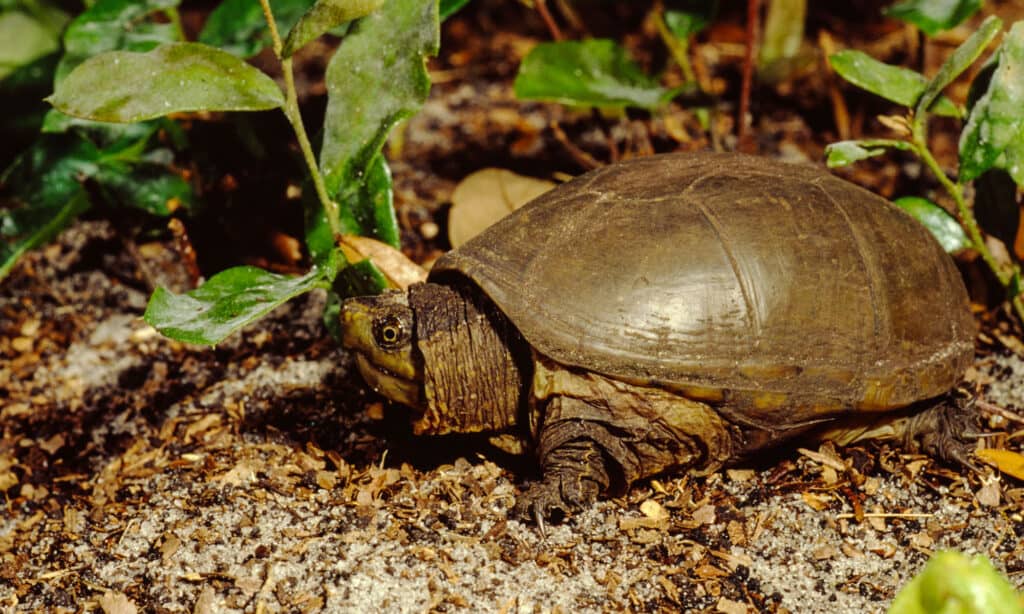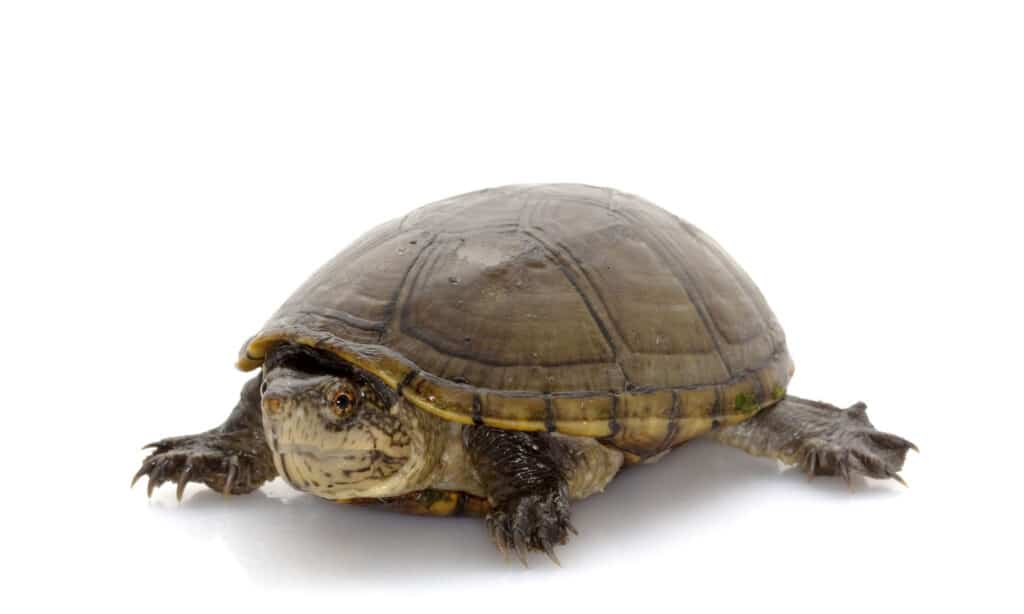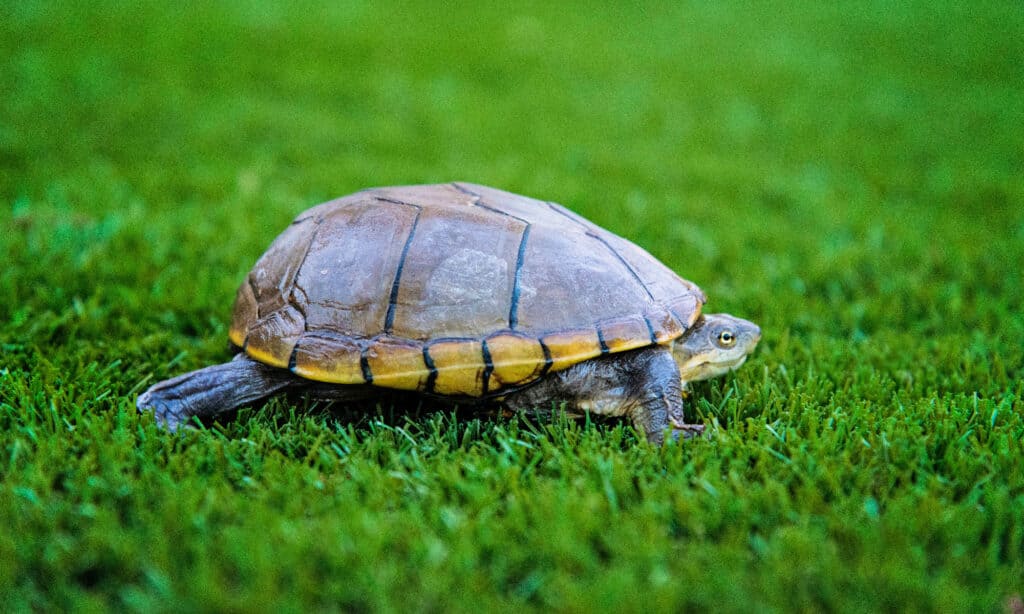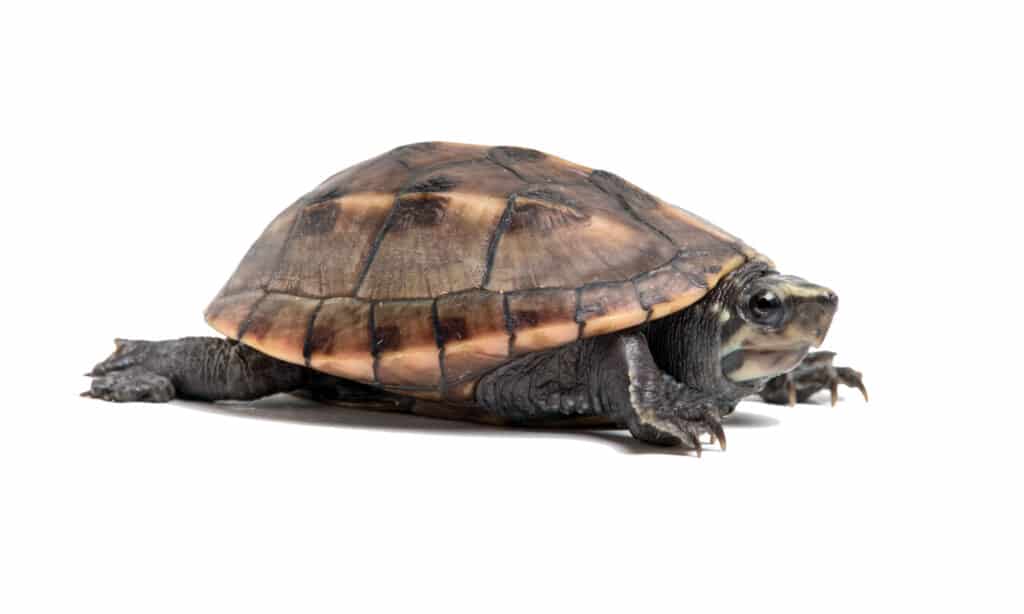Did you know that mud turtles can live up to 50 years? Incredible, isn’t it? However, their lifespan highly depends on their quality of life, especially their diet, which provides the body with the necessary nutrients to grow and stay healthy. Let’s see what mud turtles eat in the wild and what diet they should have as pets!
What Are Mud Turtles?

Liz Weber/Shutterstock.com
The aquatic turtle species in the Kinosternon genus are called mud turtles. They can be found in South America, the United States, Mexico, and Central America. There are 22 species and 15 subspecies of mud turtles. These turtles are generally smaller than musk turtles. Since there are so many mud turtle species, it will be easier to understand how they look and their feeding habits if we focus on certain species.
Yellow-mud turtles are a small species with olive carapaces, yellow throats, heads, and necks, as well as plastrons that range in color from yellow to brown.
Scorpion mud turtles live in Mexico and South and Central America. They have a domed, oval shell measuring 3.6 – 10.6 inches long. These turtles can easily adapt to any body of water.
Male Arizona mud turtles measure 4 – 7.5 inches long, while females have an average length of 3.5 – 6.5 inches. They have domed carapaces that can be olive, brown, or yellow-brown. Their marginal shields are yellow, while the tops of their heads are gray with cream bottoms and sides.
Eastern mud turtles’ carapaces measure 3 – 4 inches long and can be anything from yellow to black. They have large, double-hinged, yellow-to-brown plastrons. Their chins and throats are yellowish gray, while their limbs and tails are gray.
What Do Mud Turtles Eat?

fivespots/Shutterstock.com
Most mud turtles are either carnivorous or omnivorous and eat mostly invertebrates, fish, carrion, and plant matter.
Striped mud turtles eat insects, snails, fish, carrion, dried krill, plants, and algae.
Yellow mud turtles are also omnivorous. They feed on worms, frogs, crayfish, snails, fairy shrimp, fish, slugs, leeches, and tadpoles. Besides these, they’ll eat vegetation and dead matter.
Rough-footed mud turtles are omnivorous. They primarily eat plant material, such as filamentous algae. They may also feed on seeds and fruits, aquatic or terrestrial arthropods, and aquatic gastropods. These turtles often switch from eating insects to vegetation because it promotes rapid growth.
Mexican mud turtles eat grass seeds, filamentous algae, guava seeds, wasps, bees, and ants.
Scorpion mud turtles feed on insects and their larvae, shrimp, crabs, snails, spiders, worms, carrion, bird eggshells, fruits, nuts, algae, seeds, and aquatic plants. In captivity, these turtles may exhibit cannibalistic behavior.
Arizona mud turtles prefer eating anurans, toads, dytiscid, tadpoles, hydrophilic, carrion, and fish.
Eastern mud turtles primarily feed on insects, crustaceans, amphibians, mollusks, and aquatic vegetation.
Based on the diets of these mud turtle species, we can conclude that they’re predominantly omnivores and prefer fish, insects, amphibians, and algae.
A List of Foods Mud Turtles Eat
Here’s a list of foods mud turtles eat:
- Insects
- Crabs
- Shrimp
- Spiders
- Carrion
- Worms
- Fruits
- Algae
- Seeds
- Tadpoles
What Can You Include in Your Mud Turtle’s Diet?

Kayla Blundell/Shutterstock.com
While mud turtles eat a variety of foods in the wild, their diet in captivity should be well-adjusted and balanced. Before setting up a diet, you should research your mud turtle species to understand what they eat in the wild. This will determine your “rate of success” since the diet highly depends on whether your turtle is omnivorous or carnivorous.
Omnivorous turtles need to eat lots of greens, vegetables, and fruits, alongside animal protein. If the turtle is omnivorous, it would be best if you fed it worms, fish, snails, pellets, and sometimes vegetables, fruits, and dried insects.
They like dark green, leafy vegetables such as dandelion greens or parsley.
What Can You Feed a Little Mud Turtle?
Young turtles need food every day to encourage growth compared to adults, who can eat as rarely as 2 to 3 times a week. They eat roughly the same food as their parents, except that their food needs to be small enough for them to swallow.
Do Mud Turtles Make Good Pets?
Mud turtles make great pets. You’ll find it very easy if you know how to care for turtles. If you have no experience, it may be somewhat difficult in the beginning to adjust the diet and habitat so that it suits your mud turtle’s needs.
You should be very gentle in handling them and avoid picking them up if not necessary. That’s because they aren’t usually friendly and can bite you if they feel threatened.
Do Mud Turtles Have Predators?

davemhuntphotography/Shutterstock.com
Some mud turtle species have predators; other species don’t. For example, rough-footed mud turtles often fall prey to raccoons and feral pigs when they come on land. Bald eagles and canids can kill southeastern mud turtles. They have a double-hinged plastron to protect their hands and limbs from other strong predators.
Incredible Mud Turtle Facts
- Mud turtles can sometimes outlive their owners, as they may live up to 50 years if taken good care of!
- The eastern mud turtle is the rarest turtle species in New York.
- Mud turtles help maintain a balanced insect, snail, amphibian, and crayfish population. Moreover, they help clean the water as they also feed on dead fish.
- People often mistake mud turtles for musk turtles thanks to their similar appearance. However, if you need to tell the two apart, you can check their size, as mud turtles are smaller. Besides, their domes are flatter.
- The most common pet mud turtle species are common mud turtles, eastern mud turtles, striped mud turtles, and Mississippi mud turtles.
- Mud turtles like to hide because this helps them feel safe. So, if you have a mud turtle as a pet, you can buy some accessories that would serve as hiding spots. This way, your turtle will feel comfortable in the tank.
Up Next:
The post What Do Mud Turtles Eat? appeared first on AZ Animals.
from Animal News, Facts, Rankings, and More! - AZ Animals https://ift.tt/nlVxI4Q